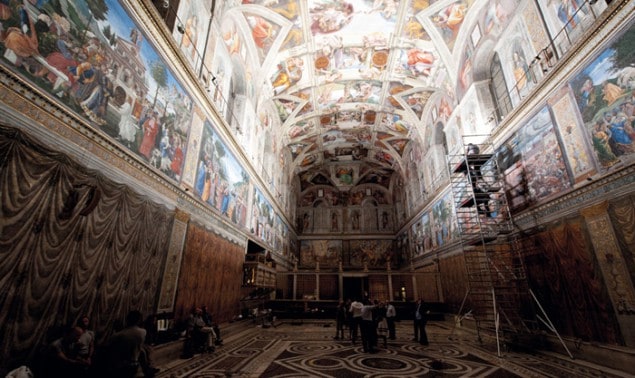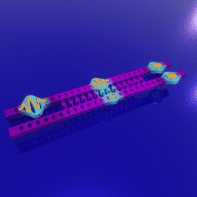
Its enormous frescos have wowed tens of millions of visitors during the past five centuries, but from autumn this year, the walls and ceilings of the Sistine Chapel in Rome will be revealed as never before. Lighting manufacturer Osram is in the process of installing 7000 LEDs in the famous building, each tuned in intensity and wavelength to provide the best possible viewing experience. Until now, the artworks have been lit via low-level natural light and metal halide lamps diffusing through glass windows to reduce long-term damage.
Based on measurements of the colour spectrum made at 280 points distributed across the chapel’s surface, Osram engineers designed lighting rigs that combine radiation from standard red, blue, green and white LEDs in precisely controlled amounts to match the pigments in individual locations. The team is aiming for a near-perfect “colour-rendering index” – a measure of the quality of a light source relative to a reference such as the Sun – of 98 compared with 80 produced by standard indoor lighting.
Better viewing, less damage
The challenge, explains Osram project leader Mourad Boulouednine, was to improve the viewing experience massively without compromising on conservation. “We have convinced the Vatican that we have the right technology for this iconic project,” he says. “These are big deals – we’re talking about a 500 m2 artwork on the ceiling and other major works such as Michelangelo’s The Last Judgment,” he says.
LEDs emit no ultraviolet (UV) or infrared radiation, which is known to be one of the main causes of damage to pigments. Still, it took some time to convince Vatican conservators to take up the technology. The Osram team carried out stringent stress tests in the Vatican museums by exposing pigments to LED radiation with an illuminance of 200,000 lux – roughly double that produced by direct sunlight – for the equivalent of one year. The results showed that, under normal LED operating conditions of 50 lux or less, the priceless pigments on the chapel’s walls would be safe for at least 1000 years – which addressed the Vatican’s concerns. “First, they saw 3D effects and other details that the artists intended but that have never been seen before,” says Boulouednine. “Then we did the stress test, and now there is not a single doubt.”
Low power, less glare
Despite boosting the illuminance by a factor of five to 10, the new lighting rig is also expected to reduce power consumption for the Sistine Chapel by more than 60%, thanks to the high energy efficiency of LEDs and careful direction of the light to ensure that artworks are uniformly illuminated without glare or light spill. Osram honed the technology last year at the Lenbachhaus Museum in Munich, and is one of several lighting firms keen to get into the museum scene.
Last year, Philips installed some 750,000 individual LEDs in the refurbished Rijksmuseum in Amsterdam, while Toshiba LEDs are being used to illuminate the Mona Lisa and other famous artworks in the Louvre. “LED lighting in particular outlines the visual contrast and relief in the paintings,” says Tim Zeedijk, who is head of exhibitions at the Rijksmuseum, in a statement. “A significant advantage of the new generation of LED lighting is that there is hardly any radiation of heat and no harmful UV being emitted. In addition, LEDs have a longer lifespan and require less maintenance than halogen lighting, which is more commonly used in museums.”
- This article also appears in the May 2014 Physics World Focus on Optics & Lasers. The magazine is free to view and contains news and feature articles on a range of topics, including 3D printing, photonic quantum circuits and a state-of-the-art satellite camera that is mapping the heavens to extraordinary precision



